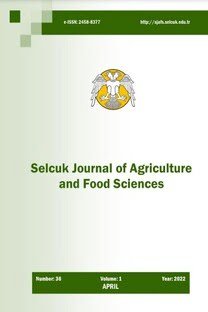Bitki patojenlerinin kontrolünde kullanılan biyokontrol ürünler ve özellikleri
biyolojik kontrol, çevre koruma, bitki patojenleri
Biocıontrol products for control of plant pathogens and their feature
biological control, environmental protection, plant pathogens,
___
- Anonymous, 2004a. Integrated plant protection center, Database of microbial biopesticides (DMB), American Phytopathological Society, http://www.ippc.orst.edu/biocontrol/biopesticides/
- Anonymous, 2004b. Commercial biocontrol products available for against plant pathogens. http://www.oardc. ohio-state. edu/ apsbcc/ productlist
- Budge, S.P., McQuilken M.P., Fenlon, J.S. and Whipps J.M., 1995. Use of Coniothyrium minitans and Gliocladium virens for biological control of Sclerotinia sclerotiorum in glasshouse lettuce. Biol. Control 5:513-22
- Cook, R. J. and Baker, K.F. 1983. The Nature and Practice of Biological Control of Plant Pathogens. American Phytopathological Society, St. Paul, MN.
- Anonymous, 2004c. United States Environmental Protection Agency. Topics: Biopesticides. Online. Office of Pesticide Programs (www.epa.gov/pesticides/biopesticides)
- Datnoff L.E., Nemec, S., Pernezny, K. 1995. Biological control of Fusarium crown and root rot of tomato in Florida using Trichoderme harzianum and Glomus intraradices. Biol. Control 5:427-31.
- Datnoff LE, Nemec S, Pernezny, K. 1995. Biological control of Fusarium crown and root rot of tomato in Florida using Trichoderma harzianum and Glomus in-traradices. Biol. Cont. 5:427-31
- Delen, N., Özbek, T. 1993. Pestisitlerin çevre kirlenmesindeki rolleri. I. Ulusal Ekolojik ve Çevre Kongresi, 5-7 Ekim, İzmir
- Delen, N., Tosun, N. 1997. Türkiye’de pestisit kullanımının toksikolojik değerlendirilmesi. II. Ulusal Toksikoloji Kongresi, 3-6 Nisan 1997, Antalya
- Elad Y, Zimand G, Zaqs Y. Zuriel S and Chet I. 1993. Use of Trichoderma harzianum in combination or alternation with fungicides to control cucumber grey mould (Botrytis cinerea) under commercial greenhouse conditions. Plant Pathol.42:324-32
- Feldman K, Keren-Zur M, Hofstein R. and Fridiender B. 1993. Ampelomyces quisqualis,an important component of an IPM program for the control of powdery mildew. Int. Congr. Plant Pathol. 6th, Abstr. 3 . 2 .11, p. 58
- Lemanceau P. and Alabouvette, C. 1991. Biological control of fusarium diseases by fluorescent Pseudomonas and non-pathogenic Fusariunm. Crop Prot. 279-86
- Lewis, J.A., Lumsden, R.D. 2001. Biocontrol of damping- off greenhouse-grown crops caused by Rhizoctonia solani with a formulation of Trichoderma spp. Crop Protection 20:49-56.
- Maplestone, P., Whipps, A., Lynch, J.M. 1991. Effect of peat-bran inoculum of Trichoderma species on biological control of Rhizoctonia solani in lectuce. Plant Soil 136, 257-263.
- McQuilken M.P. and Mohammadi, O. 1997. Evaluation of a commercial formulation of Gliocladium catenulatwnm (J1446) for biocontrol of damping-off in bedding plants. Mededc. Rijksfac. Landbouwwet. Univ. Gent. 62:987-92
- MCQuilken M.P. and Wipps J.M. 1995. Production, survival and evaluation of solid-substrate inocula of Coniothyrium minitans against Sclerotinia sclerotiorum. Eur. J. Plant Pathol. 101:101-10
- McSpadden B.B. and Fravel, D.R. 2002. Biological control of plant pathogens: Research, commercialization, and application in the USA. Plant Management Network.
- Nemec S., Datnoff, L.E. and Strandberg, J. 1996. Efficacy of biocontrol agents ir planting mixes to colonize plant roots and perparasite Ampelomyces quisqualis Ces. Z. Pflanzenkr. Pflanzensschutz 97: 120-32
- Paulitz, T.C. and Belanger, R.R. 2001. Biological control in greenhouse systems. Annu. Rev. Phytopathol. 39:103-33.
- Paulitz, T.C. and Belanger, R.R. 2001. Biological control in greenhouse systems. Annu. Rev. Phytopathol. 39:103-33.
- Vyas, S.C. 1988. Nontarget effects of Agricultural Fungicides.CRC Pres, Inc. Boca Raton, Florida, USA
- ISSN: 1300-5774
- Yayın Aralığı: 3
- Başlangıç: 2018
- Yayıncı: Selçuk Üniv. Ziraat Fak.
SİNAN SEFA PARLAT, Alp Önder YILDIZ, OSMAN OLGUN, YUSUF CUFADAR
SİNAN SEFA PARLAT, Alp Önder YILDIZ, YUSUF CUFADAR, OSMAN OLGUN
Bezelye melezlerinde bazı agronomik özellikler için tek dizi analiziyle genotipik değerlendirme
Some physical properties of safflower seed (Carthamus tinctorius L.)
Sedat ÇALIŞIR, Tamer MARKAOĞLU, ÖZDEN ÖZTÜRK, Hüseyin ÖĞÜT
Polatlı Tarım İşletmesinde yetiştirilen Siyah Alaca ineklerde bazı süt verim özellikleri
Neriman BİLGİÇ, DENİZ ALIÇ URAL
LEVENT ÜNLÜ, Levent YÜCEL, MEHMET MAMAY
Ercan ÖZKAYNAK, Bülent SAMANCI
Orta Karadeniz geçit bölgesinde kolza için en uygun ekim zamanının belirlenmesi
